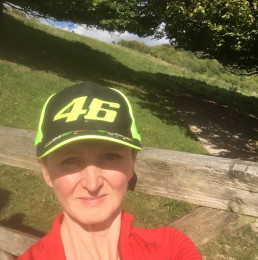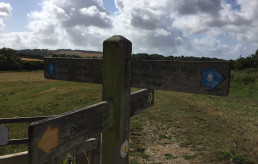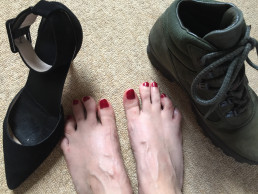Walking Test Two: Jill (not Jack) goes up Beacon Hill
Today I took a sneaky day off work and headed for the South Downs Way. My goal was to try out Beacon Hill with my walking boots and some new walking poles. And to visit what will likely be the end of the first ‘leg’ (ha!) of my South Downs Way walk; the pretty village of Exton.
I was born with hip dysplasia (DDH) which means my hip joints didn’t form properly before I was born. Early this year I realised that I spent too much energy ‘protecting’ myself physically, and that I needed to walk more to understand and push my limits. Not doing things by halves, I came up with the mad idea to walk the 100 miles of the South Downs Way. I'm also raising money for Steps charity whose slogan is ‘not everyone takes walking for granted’.
Today was a magical day to visit Beacon Hill, about 10 miles from Winchester. I had brilliant Autumn sunshine and breath-taking 360 views, and experienced nature at its best with hedgerows, lush green fields, fluffy white clouds, colourful birds and hundreds of butterflies. Unlike me, all that nature does need protecting and I’m pleased to see the #MendOurWay campaign working to protect and fix broken sections of the trail.
I wanted to try a hill, because hills present a particular challenge for the way I walk. And there are quite a few of them on the South Downs Way!
The right side of my body is my anchor. On the flat, I walk by hitching my right leg to minimise the time on my left leg and use my upper body to create momentum. On a hill, or even a slant, the mechanics of that become a bit tricky. The result is usually a pain in the neck (literally) and a sub-snail pace.
I parked at the top of Beacon Hill and walked downhill first because I actually find it harder than walking up. Up is slower. Down is way less stable, basically because I need to build my bum (J-Lo I’m not!). As it turns out, I did OK today, so my recent tricycling in the local park may be starting to work. The poles helped a lot (thanks Lidl of all places!) and I managed an average pace of 20 minutes per kilometre. I was pleased to get to Exton and met some lovely people in The Shoe pub before turning round and heading back up the hill.
I have a protection mindset about my body that doesn’t always serve me well, which is why I’m doing this walk and writing this blog. What struck me today was how it’s the things that you don’t plan for that end up being your biggest challenge. It wasn’t the hill, the boots, the poles or anything to do with my hips really. It was actually some belligerent cows who insisted on herding me across a field.
Of course this is where protection comes right back in. I had the same feeling of fear that I get when I'm somewhere really crowded where there are lots of boisterous people. Like being on the dance floor when someone decides to start the conga and tries to grab you to join in. For me that means I feel out of physical control.
In this instance it was big cows, small me. It was a great test of pushing through that fear and recognising that I can manage my own physical boundaries perfectly well. And so I just carried on walking.
And, as it turned out, there's nothing like a herd of cows to give you that extra momentum you need to get back up the hill...
You can follow my blog on Facebook @WalkingJill and if you'd like to donate something to Steps Charity please click here
Left hip, right path. Getting me walking with hip dysplasia.
Recently I found myself overnight in Alfriston which, as it happens, is directly on the South Downs Way. I had a spare hour or so and decided to walk along the path that I will return to at some point on my 100-mile walk. Straight away I had a choice - left path or right path?
This felt like a symbolic turning point as I had just spent a week on the Hoffman Process exploring my past and finding my own 'right path'. Over the course of that week I realised I have quite a sketchy memory of my childhood surgery for hip dysplaysia (DDH). In Alfriston I realised I could take the left path and remain sketchy. Or the right path - find out more and own the story of my body.
I see so many posts on the Steps Charity group from mums and dads who want to know more about the treatments and surgeries their child will go through. So I started by asking my mum about her memories of my surgeries.
I had my first operation when I was 5 months old. My left hip socket was completely missing as was part of my pelvis. So it was clear that walking was going to be a challenge. Who knows what they could do today with 3D printing or growing bones - in 1971 those were probably sci-fi!
Sheffield Children’s Hospital is a teaching hospital and my mum tells me we were regular guests in the lecture theatre there. My case was unusual so not only attracted medical students but also orthopaedic consultants from other hospitals who contributed ideas about my treatment.
My mum then tells me about a turning point when I was 3 years old. I’d had eight unsuccessful operations already – they were grafting muscle from my groin to try and strap my femur to the pelvis (being medically untrained I can only picture something like a hinge and a rubber band!). They were concerned that I was 3 now and had to get on my feet soon if I was going to walk.
On this particular day my own consultant - who was always mindful of phrasing his explanations in front of mum - wasn’t there. Instead my mum heard another consultant say “so as you can see it’s a hopeless case”. She summarily grabbed me from his arms, saying “if that’s the case, why are you putting her through any more of this” and took me home. Convinced I would not walk.
It was a turning point because it led to a vote and a decision. Three of my consultants came to see mum and dad at home. They explained that there had been a vote and some consultants had voted not to undertake further surgery. But that the three of them wanted to try one more thing. If that didn't work they would stop.
On the day of the operation, after watching me go into theatre, a nurse called mum into the office. On the table was a stack of greetings cards. They had been sent to the hospital by people from across the council estate where I grew up. The nurse turned to mum and said “This is going to work. Because this child has so many people rooting for her.”
And of course, it did. The muscles finally held the femur in place. It was my last chance to walk and I took it. Five days later I came home and took my first steps. I guess I’d watched all the other kids around me do it, I was just waiting for my turn.
Today I’ve been able to walk a few miles along the South Downs Way in Alfriston and I'm preparing for a series of big walks to complete the 100 miles from start to finish.
I know that I wouldn’t be able to consider doing that without two dedicated parents, two supportive siblings, and friends, neighbours and a community cheering me on. And a medical team in Sheffield, led by Mr DK Evans, who didn’t give up. Somehow, together, they gave me my first steps on the right path. I will always be grateful. And I intend to use them wisely.
If the shoe doesn’t fit... orthotics and hip dysplasia
Walking my first 10K for Steps last month taught me a couple of valuable lessons. Firstly, I need to build up my leg strength, particularly around my knees, or I’ll never manage the hills and rugged terrain of the South Downs Way. And secondly, I need to find some comfortable walking boots that my orthotics fit into properly, so I don’t get blisters.
This second realisation makes my heart sink. Oh no, not shoes….
Shoes have always been my personal nemesis. Practically and emotionally.
I was born with hip dysplasia (DDH). My pelvis is incomplete, crooked and I have legs that are different lengths. I also inherited some ‘unusual’ feet that are different sizes - and a left ankle that turns out a bit like Mary Poppins. I wear orthotics to correct my leg length and knee position so practically speaking, pumps or shoes that are light and tie tightly to my feet are the best.
Emotionally – well, like many women I drool over the sexy heels on display in the LK Bennett window. But shoe shopping just isn’t fun. Unlike Cinderella, the shoe rarely fits on either foot and the need to insert orthotics writes most girl-shoes off the list. When it comes to dressing up girly, I often feel more like the ugly sister than the fabled princess in waiting.
I didn’t mind shoe shopping as a kid. My orthopaedic consultant insisted on good shoes that fastened well to my feet so we always went to Clarks in the Co-op department store in Sheffield. They had animated models of the Animal Kwackers there, who I loved. Like Boots and his silver platforms there was a blingster in young Jill - so I always chose the shiny shoes with gold braiding. Happy memories.
The psychological challenges started for me as a teenager. Wearing stilettos was a marker that you were growing up and at that age I become hyper-conscious of the image that heels = sexy. So I persevered with my heels and fishnets at school (it was the 80s in a school with no uniform) because I wanted to fit in. And I wanted boys to look at me like they did the other girls. In reality heels just accentuated my limp and made me walk badly because they’re less stable.
Yet to this day I still dread dressing up for a night out where women wear sexy high heels with their dresses. My own inability to stand up, let alone walk or dance in them, makes me feel like I'm not quite cutting it as a woman. Of course, this is just my own perception - a story I've invented in my own head. But it’s honestly what goes on in it! Rationally I know it really doesn’t matter and I’m lucky I can walk. But emotions are funny things….
I was recently with a group of girlfriends who were sharing their first childhood memories. Ironically, mine is about shoes. My pre-school playgroup used to streamline the rush for bags and coats at the end of the morning, by sending you to get them according to shoe colour. “Everyone with red shoes. Now everyone with brown shoes.” It’s a happy memory for me because I got to go up on my own. I was the only one in blue shoes and I simply loved that I was different. I was differently-abled and differently-minded.
Thankfully stilettos aren’t the rage along the South Downs Way. So right now it’s about finding boots that can support but not cripple my funny ankles. And getting good orthotics that are fitted properly inside them. Since my 10K I’ve been consulting with a chiropractor and my podiatrist, and I’m being fitted for new orthotics next week.
The more I explore my life with hip dysplasia (DDH) and what goes on in my mind about that, the more I see that we’re all differently-abled. We all have things we’re not good at or a bit paranoid about. And let’s face it, you don’t need to have hip dysplasia to be crap at walking in heels!
My pledge is to try and be more like 3-year-old Jill - newly walking in her blue shoes. Walking differently. And proud of it.



